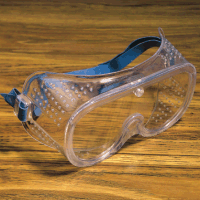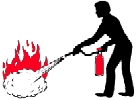
ACP Home | Organic Chemistry I | Organic Chemistry II | Lecture | Laboratory
Organic Chemistry I
Laboratory Safety

ACP Home | Organic Chemistry I | Organic Chemistry II | Lecture | Laboratory
Organic Chemistry I
Laboratory Safety
 |
Safety goggles must be worn at all times while you are in the
lab whether
you are actively engaged in experimental work or not. Goggles
must
be positioned over your eyes, not on your head. Contact lenses
should
never be worn in the laboratory because they cannot be remove rapidly
enough
if reagents accidentally splash in the eye. Shorts and short skirts (without a lab coat) may not be worn in the laboratory. Open-toed shoes (sandals) are also not allowed. Long hair and loose clothes must be confined while working in the laboratory. |
|
Learn the location and correct use of the nearest fire extinguisher. Learn the location of the safety shower, eye wash station and first aid kit. Learn evacuation procedures in the event of a fire. Be prepared to give help to others. Drinking, eating or smoking is
forbidden
in the laboratory. CHEMICALS NEVER, NEVER, NEVER GO DOWN
THE
SINK! Use the appropriate waste containers in the back hood of the
lab.
|
 |
| Gloves must be worn when handling all chemicals. Handle
every
chemical with care. Do not use mouth suction to fill
pipettes.
Avoid contact with skin and clothing. Wipe up spills immediately,
especially near the balances and reagent shelves. Replace caps on
bottles as soon as possible. Do not use organic solvents to wash
chemicals from your skin as this may actually increase the rate of
absorption
through the skin. Avoid the inhalation of organic vapors
particularly
aromatic solvents and chlorinated solvents. Use care in smelling
chemicals and do not taste them. |
 |
Good chemical hygeine provides the safest work environment. Each student is responsible for his or her lab bench area and hood area. In addition, each week assignments will be made for cleaning up areas that are common to everyone in the lab. Your neatness will be considered when determining your technique grade for the laboratory.